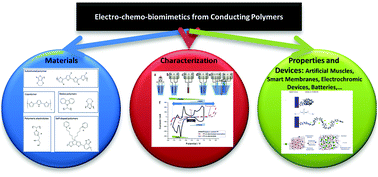Electro-chemo-biomimetics from conducting polymers: fundamentals, materials, properties and devices
Abstract
Conjugated conducting polymers, intrinsic conducting polymers or conducting polymers are complex and mixed materials; their electroactive fractions follow reversible oxidation/reduction reactions giving reversible volume variations to lodge or expel charge-balance counterions and osmotic-balance solvent molecules. The material content (reactive macromolecules, ions and water) mimics the dense intracellular matrix gel of living cells. Here the electropolymerization mechanism is reviewed highlighting the presence of parallel reactions resulting in electroactive and non-electroactive fractions of the final material. Conducting polymers are classified into nine different material families. Each of those families follows a prevalent reaction-driven exchange of anions or cations during oxidation/reduction (p-doping/p-dedoping or n-doping/n-dedoping). Polyaniline families also follow reaction-driven exchange of protons. The polymer/counterion composition changes for several orders of magnitude in a reversible way with the reversible reaction. The value of each of the different composition-dependent properties of the material also shifts in a reversible way driven by the reaction. Each property mimics another change in functional biological organs. A family of biomimetic devices is being developed based on each biomimetic property. Those electrochemical devices work driven by reactions of the constitutive material, as biological organs do. The simultaneous variation of several composition-dependent properties during the reaction announces an unparalleled technological world of multifunctional devices: several tools working simultaneously in one device. Such properties and devices are driven by electrochemical reactions: they are Faradaic devices and must be characterized by using electrochemical cells and electro-chemical methodologies.


 Please wait while we load your content...
Please wait while we load your content...